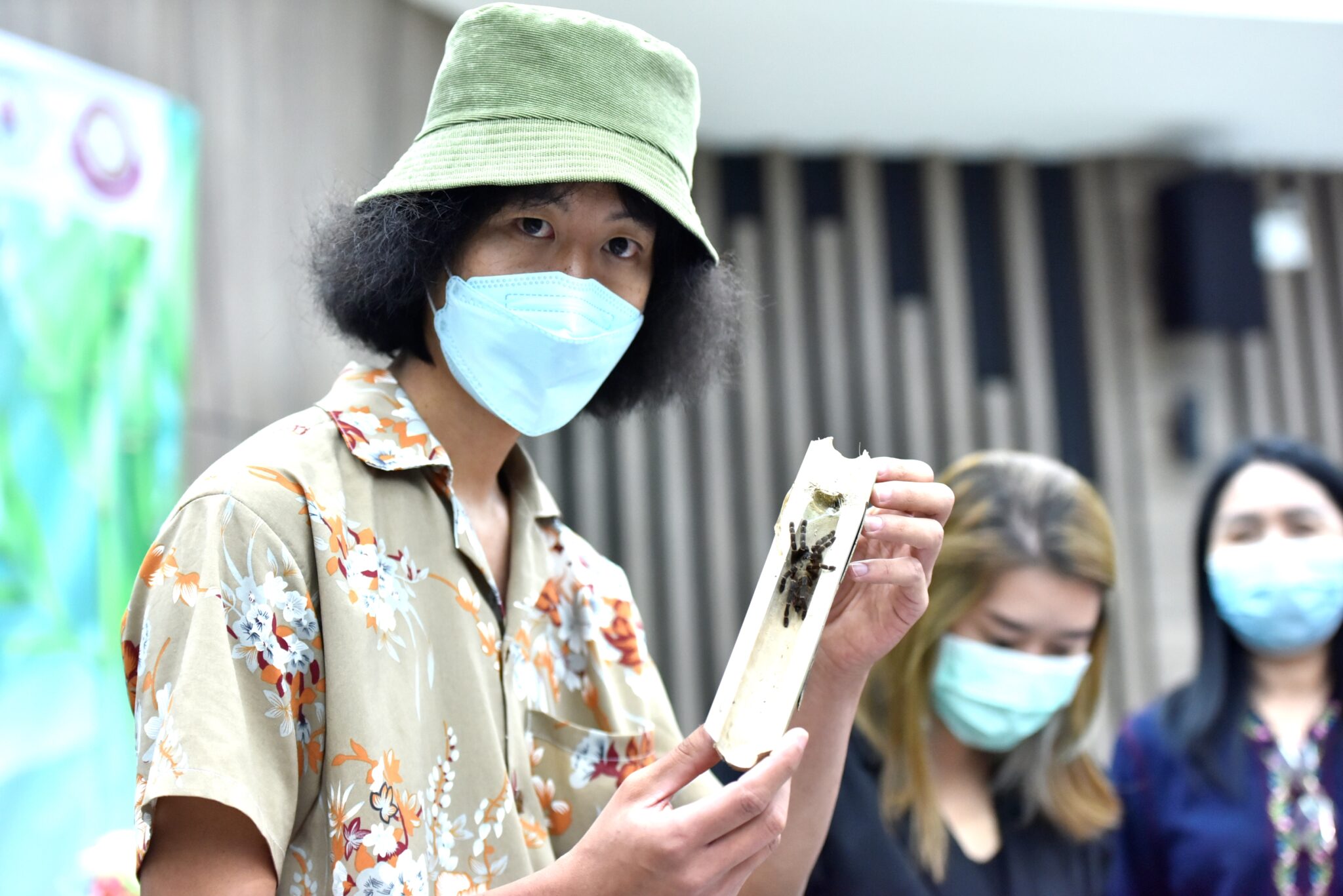Breaking news! KKU research team discovers World’s new species of gnat-like insect living in bamboo forest, 1,000 m over sea level
This marks another key discovery of a new tarantura of the world.
The first discovery of tarantura in Asia in 104 years
There has never been any tarantura with its ecology being a bamboo tree like this one.
This tarantura is considered one of the endangered animals.
Wednesday February 2, 2022 from 9:00 a.m. to 12:00 p.m. – Faculty of Agriculture, Khon Kaen University met the press to release news of the finding of a new tarantura living in bamboo trees, a new species of the world. Assoc. Prof. Darunee Chotisayangkoon, Ph.D., Dean of the Faculty led the researcher team and administrators including Assoc. Prof. Poramet Banthoeng, Ph.D., Vice Dean for Research, Innovation, and International Affairs, who made a reporting speech; Ajarn Narin Chompoopuang, Ph.D., a lecturer of the Department of Entomology and Plant Pathology, the research team leader; Mr. Chawalit Songsaenchote, a spiderology scientist from the Faculty of Forestry, Kasetsat University; Mr. Songtham Sippawat (Josho, a Youtuber in forestry and nature); Mr. Wutthikrai Khaikaew, a freelance academic; the press and a lot of interested public. The event was held at Room 5101, Faculty of Agriculture Library, Khon Kaen University.

Assoc. Prof. Darunee Chotisayangkoon, Ph.D., Dean of the Faculty of Agriculture said that this discovery was an outcome from collaboration of many parts including researchers in taxonomy and Khun Songtham Sippawat, a Youtuber in forestry and nature, who has some 4 million followers at the moment. “It is good to see that people in this generation are interested in the ecological system of the diversities of small living things. Congratulations to the discovery and I hope the research team will continue with the work. The Faculty is pleased to support research studies in all fields that will lead to utilization of bio-diversities that enable mutual supports.”

Ajarn Narin Chompoopuang, Ph.D., a lecturer of the Department of Entomology and Plant Pathology, and the research team leader said, “The background of this discovery began from Mr. Chawalit Songsaenchote, a zoologist specialized in spiders from the Faculty of Forestry, Kasetsat University, who has followed Khun Josho for a long time on Facebook. One day, Khun Josho posted a picture of Tarantura on Facebook. Khun Songtham saw that the animal looked different, and so contacted Khun Josho for more information. Khun Josho sent an example, which was brought to me by Khun Chawalit for consulting. I found that it was different from other taranturas. Next, the research team went to Tak Province to meet with Khun Josho and to find the tarantura. When we found them and carried out some study, we realized that it was an important discovery of the world, as it was the first species of tarantura found in Asia in 104 years after the latest discovery in 1917. Besides, this “Bueng Plong Phai Phra Chao Taksin” is also the first species in Thai history found and researched on by Thais.”
“In Thailand, there are many types of taranturas. Studies in ecology divide taranturas into 2 groups according to their ways of living, i.e., “earth tarantura” that live on the ground by digging a hole deep down, and “tree tarantura” that live in holes on a tree. “Bueng Plong Phai Phra Chao Taksin” is categorized under the second group, and it is the first type that lives in bamboo internodes. Their home is bamboo forests on high mountains, some 1,000 meters over the sea level. This is considered marvelous and strange ways of living due to the specificity.”
“And because this new species of tarantura is found in Tak and it marks a great discovery, Dr. Narin and his research team thought it should be named Taksinus, to celebrate Tak Province and to honor “Phra Chao Taksin Maharach”, who liberated Thailand after the second defeat of Sri Ayudhaya.”

Dr. Narin continued, “The discovery of a new species of living things is rare. The name Taksinus bambus also denotes “bamboo” or the place where they live and their identity. The discovery is very interesting, for in this world, there is no tarantura of any kind that live on bamboo. This is the answer why the news is exciting in the circle all over the world. In general, the insects are found in the ground or on a tree.”

Mr. Songtham Sippawat, a Youtuber in forestry and nature, said that he enjoys raising animals and is interested in small living creatures. One day he found a dead tarantura on the ground. He thought it looked strange and different from others that he was raising. So he posted its picture and then was contacted by Khun Chawalit from the Department of Forestry of Kasetsat University who said he wanted to conduct a study on it.

“I tried looking for more on the ground for weeks and failed. I even looked on trees and could not find any until I saw a small young one that fell from a bamboo tree. Therefore, I realized it did not live on other trees. After that I talked to the research team who was going to try to find bigger ones,” Khun Josho explained.
The discovery of Taksinus bambus was published in Zookeys, an international journal on January 4, 2022. The picture of Taksinus bambus also appears on the cover of the journal, Issue 1080 of 2022. The journal is a renowned journal in zoology of the world.

Even though the finding of Taksinus bambus is from a faraway area difficult to access, there are some ethnic groups living on high mountains and earn their living from cropping there. At present only 31% of the country area is covered with forests, but the area is continuously decreasing. There is no management of forests and forest resources utilization. Taksinus bambus is one of the endangered species. The species can be found only on high mountainous areas in the North of Thailand. The research on the animal will lead to other studies in biology, ecology and culturing in the future and in turn will result in the conservation and prevention of extinction of the breeds, nurturing the ecological system of the country in the long run.
News: Rawiporn Saisaenthong
Photos: Boriphat Thasi and the research team
[Thai]



















